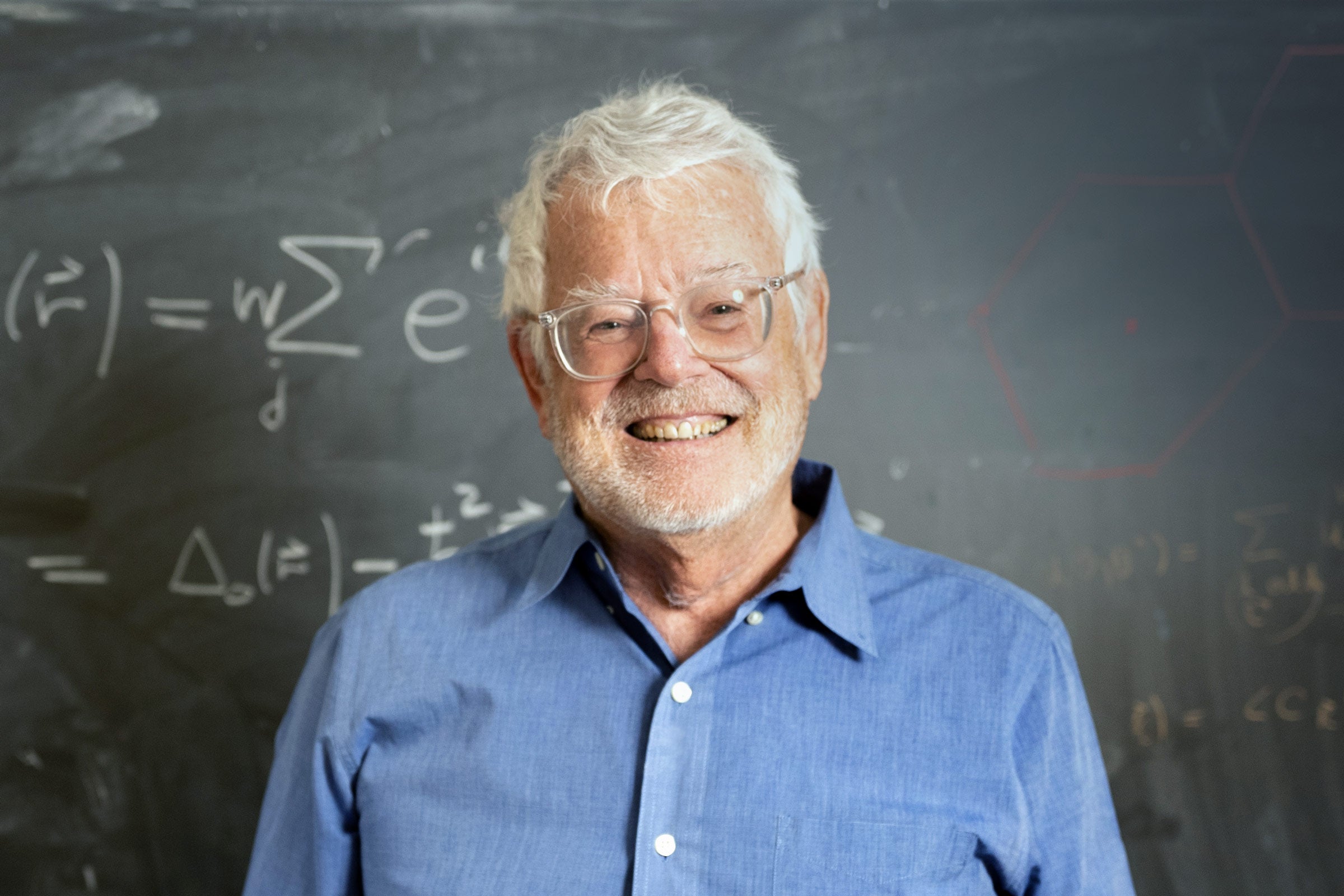Scientists use Exotic Stars to Tune into Hum from Cosmic Symphony
A team of astrophysicists has found evidence for gravitational waves that oscillate with periods of years to decades.

Credit: NANOGrav/Sonoma State University/Aurore Simonnet
Astrophysicists using large radio telescopes to observe a collection of cosmic clocks in our galaxy have found evidence for gravitational waves that oscillate with periods of years to decades, according to a set of papers published today in The Astrophysical Journal Letters.
The gravitational-wave signal was observed in 15 years of data acquired by the North American Nanohertz Observatory for Gravitational Waves (NANOGrav) Physics Frontiers Center (PFC), a collaboration of more than 190 scientists from the US and Canada who use pulsars to search for gravitational waves. The team includes Kimberly Boddy, an assistant professor of physics at The University of Texas at Austin, and UT Austin physics graduate student Jonathan Nay. International collaborations using telescopes in Europe, India, Australia and China have independently reported similar results.
While earlier results from NANOGrav uncovered an enigmatic timing signal common to all the pulsars they observed, it was too faint to reveal its origin. The 15-year data release demonstrates that the signal is consistent with slowly undulating gravitational waves passing through our galaxy.
“This is key evidence for gravitational waves at very low frequencies,” says Vanderbilt University’s Stephen Taylor, who co-led the search and is the current chair of the collaboration. “After years of work, NANOGrav is opening an entirely new window on the gravitational-wave universe."
Unlike the fleeting high-frequency gravitational waves seen by ground-based instruments like LIGO (the Laser Interferometer Gravitational-wave Observatory), this continuous low-frequency signal could be perceived only with a detector much larger than the Earth. To meet this need, astronomers turned our sector of the Milky Way Galaxy into a huge gravitational-wave antenna by making use of exotic stars called pulsars. NANOGrav’s 15-year effort collected data from 68 pulsars to form a type of detector called a pulsar timing array.
A pulsar is the ultra-dense remnant of a massive star's core following its demise in a supernova explosion. Pulsars spin rapidly, sweeping beams of radio waves through space so that they appear to “pulse” when seen from the Earth. The fastest of these objects, called millisecond pulsars, spin hundreds of times each second. Their pulses are very stable, making them useful as precise cosmic timepieces.
Over 15 years of observations with the Arecibo Observatory in Puerto Rico, the Green Bank Telescope in West Virginia, and the Very Large Array in New Mexico, NANOGrav has gradually expanded the number of pulsars they observe.
“Pulsars are actually very faint radio sources, so we require thousands of hours a year on the world’s largest telescopes to carry out this experiment,” Maura McLaughlin of West Virginia University and co-director of the NANOGrav PFC explains. “These results are made possible through the National Science Foundation’s (NSF’s) continued commitment to these exceptionally sensitive radio observatories.”
Einstein’s theory of general relativity predicts precisely how gravitational waves should affect pulsar signals. By stretching and squeezing the fabric of space, gravitational waves affect the timing of each pulse in a small but predictable way, delaying some while advancing others. These shifts are correlated for all pairs of pulsars in a way that depends on how far apart the two stars appear in the sky.
“The large number of pulsars used in the NANOGrav analysis has enabled us to see what we think are the first signs of the correlation pattern predicted by general relativity,” says Oregon State University’s Xavier Siemens, co-director of the NANOGrav PFC.
NANOGrav’s most recent dataset shows growing evidence for gravitational waves with periods of years to decades. These waves could arise from orbiting pairs of the most massive black holes in the entire universe: billions of times more massive than the Sun, with sizes larger than the distance between the Earth and the Sun. Future studies of this signal will open a new window on the gravitational-wave universe, providing insight into titanic black holes merging in the hearts of distant galaxies.
In addition, gravitational ripples produced fractions of a second after the Big Bang may make up some fraction of the signal, offering insight into how the universe itself was formed and what kind of new particles may exist in nature.
“Detecting primordial gravitational waves would provide us a direct window into the earliest stages our universe’s history that are otherwise inaccessible, allowing us to study fundamental physics and cosmology at very high energies,” said Boddy, who with Nay and others on the team explored a suite of exotic models that predict primordial gravitational waves, as well as models of dark matter that can imprint unique signatures in the data. They used high-performance computing resources at the Texas Advanced Computing Center to perform their analyses.
They used TACC’s Stampede2 supercomputer to search for evidence of dark matter particles that have extremely small masses, around one trillionth of one trillionth of the mass of an electron. The researchers performed over a dozen different analyses that placed constraints on such models. Each analysis used Markov chain Monte Carlo techniques to sample hundreds of parameters, with each point in parameter space involving operations on matrices with hundreds of millions of entries.
Support from the National Science Foundation (NSF) has been critical to NANOGrav’s success by providing support for scientific work through the Physics Frontiers Center program and through access to multiple world-class radio telescopes. Future NANOGrav results will incorporate data from Canada’s CHIME telescope, added to the project in 2019.
"The NSF NANOGrav team created, in essence, a galaxy-wide detector revealing the gravitational waves that permeate our universe," says NSF Director Sethuraman Panchanathan. "The collaboration involving research institutions across the U.S. shows that world-class scientific innovation can, should and does reach every part of our nation.”
Astrophysicists around the globe have been busy chasing this gravitational-wave signal. Several papers released today by the Parkes Pulsar Timing Array in Australia, the Chinese Pulsar Timing Array, and the European Pulsar Timing Array/Indian Pulsar Timing Array report hints of the same signal in their data. Through the International Pulsar Timing Array consortium, regional collaborations are working together to combine their data in order to better characterize the signal and search for new types of sources.
“Our combined data will be much more powerful,” says Taylor. “We’re excited to discover what secrets they will reveal about our Universe.”
The NANOGrav collaboration receives support from National Science Foundation Physics Frontiers Center award numbers 1430284 and 2020265, the Gordon and Betty Moore Foundation, NSF AccelNet award number 2114721, a Natural Sciences and Engineering Research Council of Canada (NSERC) Discovery Grant, and the Canadian Institute for Advanced Research (CIFAR). The Arecibo Observatory is a facility of the National Science Foundation operated under cooperative agreement (#AST-1744119) by the University of Central Florida (UCF) in alliance with Universidad Ana G. Méndez (UAGM) and Yang Enterprises (YEI), Inc. The Green Bank Observatory and The National Radio Astronomy Observatory are facilities of the National Science Foundation operated under cooperative agreements by Associated Universities, Inc.



